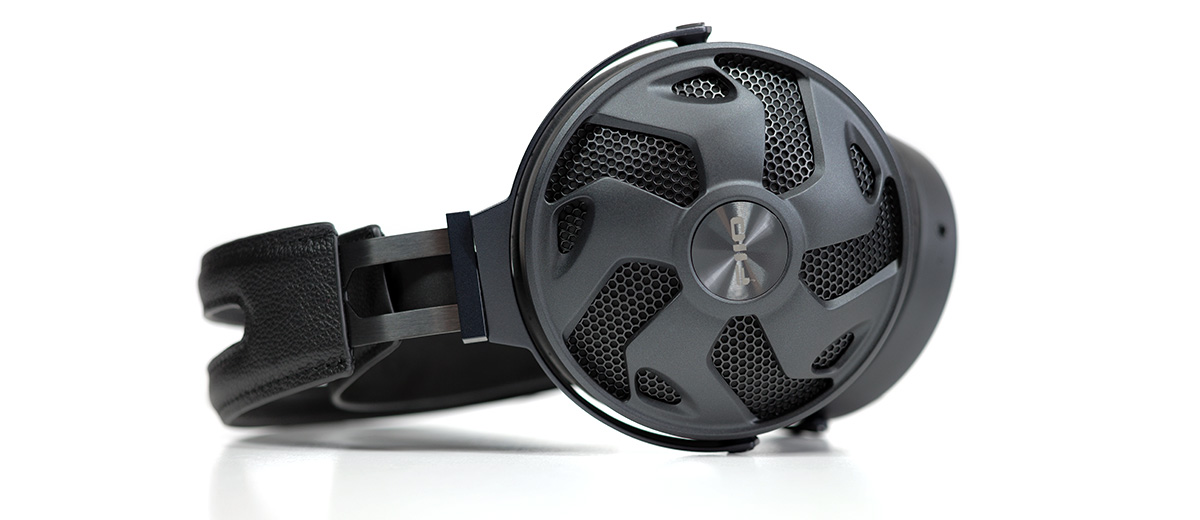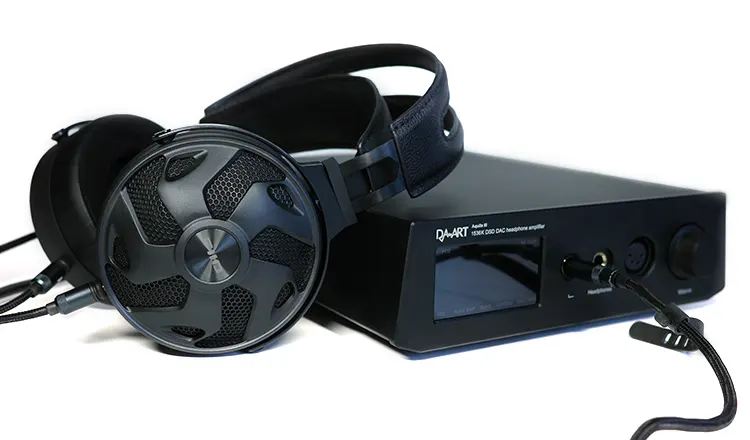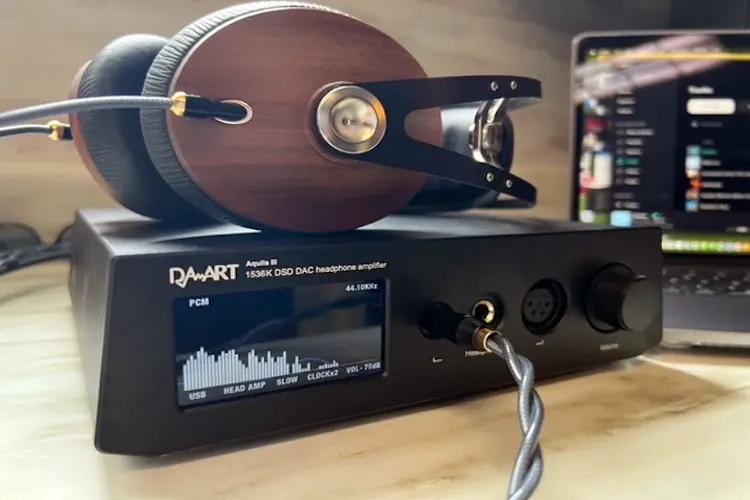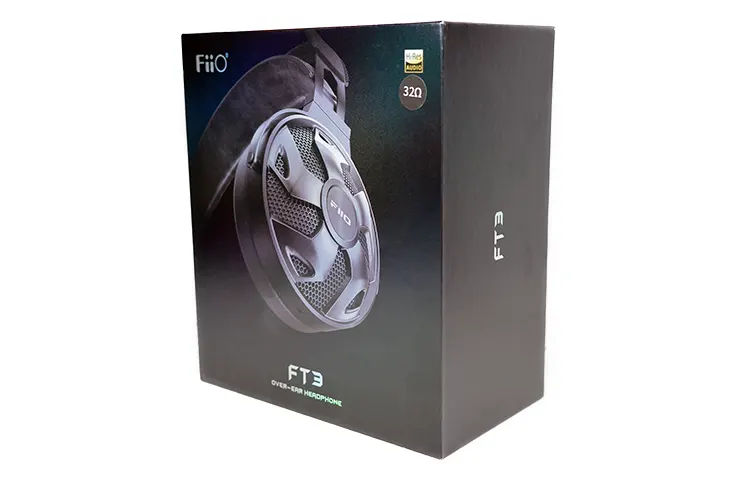Synergy
Efficiency
With a sensitivity a bit higher than the 350Ω model at 110db (1Vrms) @1kHz, the background was still silent and the FT3 32 Ohm but of course, it is much easier to drive with a 32Ω rating.
When combined with more powerful desktop amplifiers such as the Aquila III, it is best to use the balanced options. This will give you more headroom with which to play with the FT3 32 Ohm providing a more expansive sound with this option as well.
No matter the source, the FT3 32 Ohm was not lacking in providing a listenable level, volume-wise. The high efficiency made the unit easy to drive, even off my iPhone 13 Pro Max using a dongle. The sound emanating from the phone was quite good, especially when using a quality dongle.
DAP Pairings
Since the FT3 32 Ohm is marketed for its ease of use, while providing a sound in the same ballpark as the 350Ω model; it should be easier to drive across more sources. I did find that the choice of Jack changed the FT3’s response more than some, but none were outside the realm of what I consider quite acceptable.
The Shanling M6 Pro is a favorite DAP of mine, and I used the 4.4 balanced jack for listening exclusively. The synergy came across as more vibrant than one might expect given the warm signature both exude.
Using the 4.4 balanced jack overcame a lack of details wrought from a smooth signature providing me with very good detail, especially on guitar-laden songs. Note weight was still thicker but engaging as a result.
Conversely, the Cayin N6ii, using the 3.5 single-ended jack was not as tolerant. The vibrant nature of the Cayin was not quite as pleasing as the Shanling.
There was slightly more detail wrought from the Cayin, but the pairing seemed to fight for center stage. I do have little doubt that utilizing another motherboard, with a 4.4-balanced jack would have countered this seeming mismatch.
Amplifier Pairings
When paired with the YULONG Aquila III through the XLR though, the FT3 32 Ohm came to light. The soundstage opened up, and detail came more to the forefront, which had not been as pervasive on the DAP sources.
Note weight was full, but not bloated. The separation of instruments laid a 3D presentation, which was excellent. The bass reach giving a good foundation set the tone for mids, which came a small bit forward, but not lifted.
Superb vocal presentations resulted in the pairing, and I came to truly appreciate the tuning of the FT3 32 Ohm in this iteration.
While the pairing of sources with the FT3 32 Ohm seemed to be a bit finicky, I can say that it did scale well. Provide a better source (such as the Aquila III) and you will be rewarded.
This is not to dispel the performance with the DAPs but to note the better character presented with the dedicated DAC/Amplifier.
Select Comparisons
FiiO FT3 350Ω Edition
Technical
With a Beryllium-plated gasket accompanying the 60mm dynamic driver, the FT3 350 Ohm carries a sensitivity of 105dBs. The longer cable made from Furukawa monocrystalline copper, denotes possible use in the studio and provides a bit of warmth to the signature.
Design
Identical to the lower impedance model, except for the cable and coated driver, I found one difference. The adjustable suspension is seemingly lighter in pressure. This in turn made the headphones a bit less stable, with less ear pressure. A minor issue, and one, which did not hinder performance.
Performance
The 350Ω version is tuned for a more reference-like signature, hinting at possible studio use. More detail was present in the signature, with a slight rise at both 6kHz and 10kHz (with a slight dip between) in an otherwise nearly flat frequency response.
Those peaks do push cymbal hits and sharper instruments to the forefront, but without becoming edgy. An accurate representation allows for the full weight of notes in those upper regions to give the signature a lot of clarity.
The smooth tuning below that region does not make for a signature that lacks character, either. The bass push gives a certain amount of reverb and rumble when called upon, or simply a foundational aspect when otherwise needed.
That smoother signature paired with the treble peaks does make for a thoroughly engaging sound, which also happens to be vibrant and crisp. Accentuation is there where needed allowing the sound to come across with a clean and crisp signature.
Drop x Sennheiser HD 6xx
Technical
Another of the affordable, high-impedance open-back headphones, the HD 6xx comes with the familial 42 mm transducer and 38 mm diaphragm of the HD 650. A frequency response of 10 Hz – 41 kHz and a nominal impedance of 300Ω make the HD 6xx harder to drive than the FT3 32 Ohm edition.
Design
The tried-and-true 6xx series carries the familiar teardrop ear cup shape of its Sennheiser kin, one of the most recognizable shapes around.
A single band provides the support, with a higher clamp pressure than the FT3 32 Ohm’s dual-band system. Fit is very good, even with the narrower ear cups, but with increased clamp pressure comes some discomfort in long sessions.
The stock cable is shorter than most, and much has been said about it. An easy change for a modest amount can alleviate this. It is acceptable for portable use (provided your source can accommodate the higher impedance), but none too long.
Performance
When going after the “king” so to speak, one best not miss. In Michael’s review of the HD 6XX, he noted, “…quite literally the best open-back headphone deal that exists and I hope it forces Sennheiser to wake up and go back to their roots.”
The smooth, laid-back presentation, with a balanced midrange and natural-sounding bass, makes for a wonderful near-reference-like signature. Mids, including vocals are sublime, and presented with better authority (note-weight) than the FT3 32 Ohm, but only minimally so.
The HD6xx is indeed harder to drive, but when used with an acceptable source such as the Aquila III or Drop x XDuoo TA-84, the listener is rewarded with an authoritative signature that is vibrant yet smooth.
With not quite as much brilliance as the FT3 350Ω, the smooth character is engaging and authoritative, but laid-back like the FT3 32 Ohm.
Detail retrieval and clarity are slightly better as well when properly driven. This decision may come down to whether you have the power to properly drive the HD 6xx. If not, the FT3 32 Ohm is an excellent alternative.
Meze 99 Classics
Technical
The transducer dynamic driver is smaller at 40mm, with a frequency response of 15Hz – 25KHz. The sensitivity of 103dB at 1KHz, 1mW, and impedance of 32Ω make it slightly harder to drive. The 99 Classics is also a closed-back headphone.
Design
Attractive in looks and feel, the 99 Classics had stood the test of time with numerous iterations. Light even with the wood ear cups, the Meze is simply stunning in design (to me). Clamp pressure is just right, even with smaller cups than the FiiO FT3 32 Ohm.
The sub-suspension band is very similar to the FT3 32 Ohm as well, providing just the right amount of pressure and fit. I did note it to be slightly lower in tension than the FiiO, and as a result, the Meze rides further down on my head, but with less pressure below the ears.
Performance
An older classic, but a marker the FT3 32 Ohm should aim for, the Meze 99 Classics can be had new for nearly the same price, and a used version can be had for a song. The subdued looks belie a presentation, that provides more sub-bass than the FiiO, but with a bit of bloating and less control.
The mids come across as more in your face as well but are hindered a bit by that emphasis down low. The drop at 3kHz makes for a bit more hollow region than the Ft3 32 Ohm, and the spike at 10kHz tries to counter that hole higher up. It does so well, but not as well or controlled as the FiiO.
A more even signature emanates from the FT3 32 Ohm, which in this comparison is good. No spikiness means there isn’t as piercing a sound as the Meze has through the mid-treble to upper-treble region.
While not out of character in the Meze tuning, I did find myself reaching to lower the volume when solos came about such as an electric organ, or high guitar licks. Still a “classic,” but the tuning of the FT3 32 Ohm shows that even a classic can be made better.
Our Verdict
Having spent well over 100 hours with the FT3 32 Ohm including referencing in a few other reviews, I have come to appreciate the tuning of it. Even if it may not be class-leading like the HD 6xx, it is different enough to give the consumer a real conundrum.
There is enough to like about the new lower impedance model to make it well worth the effort in comparison to the established headphone benchmarks in this price range.
The fit is excellent for long listening sessions. Two choices in the pad department come standard and make changing the signature as easy as snapping one set off, and the other on. The multitude of interchangeable jacks is also well thought out and a nice inclusion.
The increased heat capacity of the pleather/suede pads can easily be lived with due to those differing signatures in the two pad choices. In an extremely tough segment, FiiO now just happens to have two open-back headphones, which can compete very well against those established markers.
FiiO FT3 32 Ohm Edition Technical Specifications
- Design: Open-back design
- Driver: 60mm dynamic driver
- LCP Aluminum Metal Plated & Aluminum Metal Diaphragm
- Frequency Response: 7Hz – 40kHz
- Sensitivity: 110db (1Vrms) @1kHz
- Impedance: 32Ω
- Cable length: 1.5m
- Cable: 392 Wire High-Purity Silver-plated Monocrystalline Copper Cable, 3.5mm jacks
- Cable ends: 3.5mm single-ended, 4.4mm balanced, 6.35mm single-ended, XLR 4-pin balanced
- Weight: 391g (minus cable)








